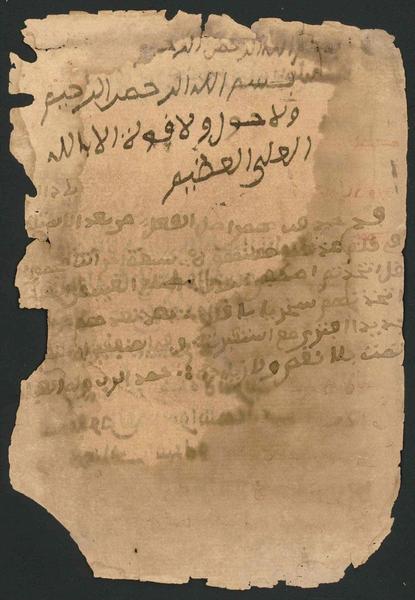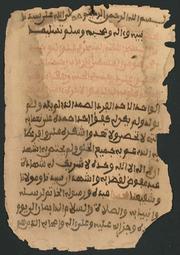File:The Beautiful Jewels for Edification in the Pillars of the Faith WDL9665.pdf

Original file (893 × 1,291 pixels, file size: 28.22 MB, MIME type: application/pdf, 116 pages)
Captions
Captions
Summary[edit]
| Author |
Русский: Хартуми, Арбаб
Français : Khartūmī, Arbab
English: Kharṭūmī, Arbab
中文:阿巴伯·克哈特乌米
Português: Kharṭūmī, Arbab
العربية: أرباب خرطومي
Español: Kharṭūmī, Arbab |
| Title |
Русский: Прекрасные драгоценности для назидания в столпах веры
Français : Les joyaux magnifiques de l'édification des piliers de la foi
English: The Beautiful Jewels for Edification in the Pillars of the Faith
中文:信仰的支柱——给人启迪的金玉良言
Português: As belas joias para edificação nos pilares da fé
العربية: الجواهر الحسان في معرفة أركان الإيمان
Español: Las hermosas joyas de la edificación sobre los pilares de la fe |
| Description |
Русский: Тимбукту, (современный город Томбукту в Мали), основанный около 1100 года как коммерческий центр для ведения торговли в регионе Сахары, одновременно являлся важным центром исламского образования с XIV века и далее. В библиотеках Тимбукту хранилось множество ценных рукописей, выполненных в различных стилях арабского письма, которые записывались и переписывались писцами и учеными Тимбукту. Эти труды являются самым известным и наиболее ценным вкладом города в исламскую и мировую цивилизацию. В данной книге представлены столпы имана, основные принципы исламской веры. ". Al-Jawāhir al-Ḥisan fī Ma‘rifat Arkān al-Īmān" ("Прекрасные драгоценности для назидания в столпах веры"), охватывают такие элементы веры, как вера в Бога, его ангелов, посланников и священные писания. Арбаб аль-Хартуми также рассуждает о вере в Страшный суд и неизбежности Божьей воли, которые независимы от человеческого понимания или желания.
Арабская каллиграфия; Арабские рукописи; Ислам – Доктрины; Исламские рукописи; Рукописи Тимбукту Français : Timbuktu (aujourd'hui Tombouctou, au Mali) fut fondée aux environs de 1100, pour servir de carrefour aux échanges commerciaux à travers le désert du Sahara. Ce fut également un très grand siège de l'enseignement islamique à partir du XIVe siècle. Les bibliothèques de Tombouctou contiennent de nombreux manuscrits importants, dans différents styles d'écritures arabes, écrits et copiés par des scribes et des érudits locaux. Ces œuvres représentent la contribution la plus célèbre et durable de la ville à la civilisation islamique et mondiale. Cet ouvrage présente les piliers de l'Iman, principes fondamentaux de la foi islamique. Al-Jawāhir al-Hisan fi Ma‘rifat Arkān al-Īmān (Les joyaux magnifiques de l'édification des piliers de la foi) définit les éléments de la foi, notamment la croyance en Dieu, en ses anges et en ses messagers, et dans les écritures. Arbāb al-Khartūmi évoqua également la croyance dans le jugement dernier et la fatalité de la volonté de Dieu, indépendamment de la compréhension humaine ou du désir.
Calligraphie arabe; Manuscrits arabes; Islam -- Doctrines; Manuscrits islamiques; Manuscrits de Tombouctou English: Timbuktu (present-day Tombouctou in Mali), founded around 1100 as a commercial center for trade across the Sahara Desert, was also an important seat of Islamic learning from the 14th century onward. The libraries there contain many important manuscripts, in different styles of Arabic scripts, which were written and copied by Timbuktu’s scribes and scholars. These works constitute the city’s most famous and long-lasting contribution to Islamic and world civilization. The Pillars of Iman, the fundamental principles of the Islamic faith, are presented in this book. Al-Jawāhir al-Ḥisan fī Ma‘rifat Arkān al-Īmān (The beautiful jewels for edification in the Pillars of the Faith) covers the elements of faith, including belief in God, his angels and messengers, and the scriptures. Arbāb al-Kharṭūmī also discussed belief in the last judgment and the inevitability of God's will, irrespective of human understanding or desire.
Arabic calligraphy; Arabic manuscripts; Islam -- Doctrines; Islamic manuscripts; Timbuktu manuscripts 中文:廷巴克图(现今马里的通布图城)约建于 1100 年,是跨撒哈拉沙漠的商贸中心,14 世纪后在伊斯兰文化学习方面也占据着一席之地。廷巴克图的图书馆中藏有很多重要的手稿,这些手稿具有不同的阿拉伯文风格,均为廷巴克图的抄写员和学者书写和誊抄。这些作品见证了这座城市对伊斯兰和世界文明所做出的卓越而又意义深远的贡献。. Al-Jawāhir al-Ḥisan fī Ma‘rifat Arkān al-Īmān(《信仰的支柱——给人启迪的金玉良言》)陈述了伊斯兰信仰的基本原则“伊玛尼的支柱”,涵盖了信仰的要素,包括督信真主和他的天使与信使,以及信仰圣典。阿巴伯·克哈特乌米 (Arbāb al-Kharṭūmī) 还讨论了对最后的审判的信念,以及不论人类的认知或欲望如何,真主的旨意不可逃避。
阿拉伯文书法; 阿拉伯语手稿; 伊斯兰教 -- 教条; 伊斯兰手稿; 廷巴克图手抄本 Português: Timbuktu (atual Tombouctou em Mali), fundada em torno de 1100 como centro comercial de negócios no deserto do Saara, foi também uma importante sede de aprendizagem islâmica, do século XIV em diante. As bibliotecas do lugar contêm muitos manuscritos importantes, em diferentes estilos de escrita árabe, que foram escritos e copiados por escribas e acadêmicos de Timbuktu . Estas obras constituem a mais famosa e duradoura contribuição da cidade ao mundo islâmico e à civilização mundial. Os Pilares do Imã, os princípios fundamentais da fé islâmica, são apresentados neste livro. O Al-Jawāhir al-Ḥisan fī Ma‘rifat Arkān al-Īmān (As belas joias para edificação nos pilares da fé) aborda os elementos de fé, incluindo a crença em Deus, em seus anjos, seus mensageiros e nas escrituras. Arbāb al-Kharṭūmī também discutiu a crença no julgamento final e a inevitabilidade da vontade de Deus, independente da compreensão ou do desejo humano.
Caligrafia árabe; Manuscritos árabes; Islã -- Doutrinas; Manuscritos islâmicos; Manuscritos Timbuktu العربية: تم تأسيس تِمبكتو (والمعروفة حالياً بتمبكتو في مالي) حوالي عام 1100 لتكون مركزاً تجارياً عبر الصحراء الكبرى، كما كانت مركزاً هاماً للتعليم الإسلامي بدايةً من القرن الرابع عشر. تحتوي مكتباتها على الكثير من المخطوطات الهامة المكتوبة بالأساليب العربية المختلفة والتي كتبها ونسخها نُساخ تمبكتو وعلماؤها. وتمثل هذه الأعمال أشهر إسهام للبلدة في الحضارة الإسلامية والعالمية وأدومها. يوضح كتاب الجواهر الحسان في معرفة أركان الإيمان أركان الإيمان، وهي القواعد الأساسية للإسلام، كما يغطي عناصر الإيمان، والتي تتضمن الإيمان بالله وملائكته ورسله وكتبه. كما ناقش أرباب الخرطومي الإيمان باليوم الآخر وحتمية وقوع إرادة الله بغض النظر عن فهم البشر أو رغبتهم.
الخط العربي; المخطوطات العربية; الإسلام -- المذاهب; المخطوطات الإسلامية; مخطوطات تمبكتو Español: Timbuctú (hoy Tombuctú, en Malí), fundada cerca del año 1100 como centro comercial para todo el desierto del Sahara, también fue un importante centro de enseñanza islámica a partir del siglo XIV. Sus bibliotecas contienen muchos manuscritos importantes en diferentes estilos de escritura árabe que fueron escritos y copiados por los escribas y eruditos de Timbuctú. Estas obras constituyen la contribución más famosa y duradera de la ciudad a la civilización islámica y mundial. En este libro se presentan los pilares del imán: los principios fundamentales de la fe islámica. Al-Jawāhir al-Ḥisan fī Ma‘rifat Arkān al-Īmān (Las hermosas joyas de la edificación sobre los pilares de la fe) abarca los elementos de la fe, que incluyen la creencia en Dios, sus ángeles y mensajeros, y en las escrituras. Arbāb al-Kharṭūmī también trata sobre la creencia en el juicio final y la inevitabilidad de la voluntad de Dios, independientemente de la comprensión o el deseo humanos.
Caligrafía árabe; Manuscritos en árabe; Islam - Doctrinas; Manuscritos islámicos; Manuscritos de Tombuctú |
| Date |
between 1500 and 1900 date QS:P571,+1500-00-00T00:00:00Z/6,P1319,+1500-00-00T00:00:00Z/9,P1326,+1900-00-00T00:00:00Z/9 |
| Medium |
Русский: Рукописи
Français : Manuscrits
English: Manuscripts
中文:手稿
Português: Manuscritos
العربية: مخطوطات
Español: Manuscritos |
| Collection |
Русский: Мемориальная библиотека Мамма Хайдара
Français : Bibliothèque commémorative Mamma Haidara
English: Mamma Haidara Commemorative Library
中文:海达拉家族纪念图书馆
Português: Biblioteca Comemorativa Mamma Haidara
العربية: مكتبة ماما حيدرة التذكارية
Español: Colección Conmemorativa Mamma Haidara |
| Place of creation |
Русский: Томбукту
Français : Tombouctou
English: Tombouctou
中文:通布图
Português: Tombouctou
العربية: تمبكتو
Español: Tombuctú |
| Notes | Original language title: الجواهر الحسان في معرفة أركان الإيمان |
| References | http://hdl.loc.gov/loc.wdl/wdl_mhcl.9665 |
| Source/Photographer |
http://dl.wdl.org/9665/service/9665.pdf
|
Licensing[edit]
|
This is a faithful photographic reproduction of a two-dimensional, public domain work of art. The work of art itself is in the public domain for the following reason:
The official position taken by the Wikimedia Foundation is that "faithful reproductions of two-dimensional public domain works of art are public domain".
This photographic reproduction is therefore also considered to be in the public domain in the United States. In other jurisdictions, re-use of this content may be restricted; see Reuse of PD-Art photographs for details. | |||||
File history
Click on a date/time to view the file as it appeared at that time.
| Date/Time | Thumbnail | Dimensions | User | Comment | |
|---|---|---|---|---|---|
| current | 02:29, 15 March 2014 |  | 893 × 1,291, 116 pages (28.22 MB) | Fæ (talk | contribs) | =={{int:filedesc}}== {{Artwork |artist = |author ={{ru|1=Хартуми, Арбаб}} {{fr|1=Khartūmī, Arbab}} {{en|1=Kharṭūmī, Arbab}} {{zh|1=阿巴伯·克哈特乌米}} {{pt|1=Kharṭūmī, Arbab}} {{ar|1=أرباب خرطومي}} {{es|1=Khar... |
You cannot overwrite this file.
File usage on Commons
The following page uses this file:
File usage on other wikis
The following other wikis use this file:
- Usage on ar.wikipedia.org
Metadata
This file contains additional information such as Exif metadata which may have been added by the digital camera, scanner, or software program used to create or digitize it. If the file has been modified from its original state, some details such as the timestamp may not fully reflect those of the original file. The timestamp is only as accurate as the clock in the camera, and it may be completely wrong.
| Image title | This document was downloaded from the World Digital Library (http://www.wdl.org). Go to http://hdl.loc.gov/loc.wdl/wdl.9665 for more information about this item. |
|---|---|
| Keywords | This document was downloaded from the World Digital Library (http://www.wdl.org). Go to http://hdl.loc.gov/loc.wdl/wdl.9665 for more information about this item. |
| Conversion program | Mac OS X 10.6.8 Quartz PDFContext |
| Encrypted | no |
| Page size |
|
| Version of PDF format | 1.3 |
